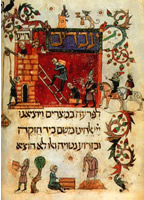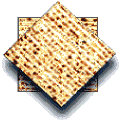 |
 |
Illuminated
Haggadah mid-14th century Spain |
matzah |
The Jewish festival of Pesach—more commonly known by the English word ‘Passover’—commemorates the liberation of the ancient Israelites from slavery as told in the biblical book of Exodus. Typically lasting from 6-8 days, the highlight occurs on one of the first two nights, when friends and family gather for a special meal, the seder. Seder means ‘order’ and the sequence of ritual and narrative to be followed during the meal can be found in special books known as Haggadah.*
Each
item in the meal is replete with symbolic significance, for example bitter
herbs (most often horseradish) representing the bitterness of slavery,
the karpas (greens such as parsley dipped in salt water) to represent
tears, and charoset (a paste made of fruit, nuts and wine) which
is meant to symbolise the mortar used by the slaves during their forced
labour.
The observance is also known as the feast of unleavened bread. Before
the festival begins there is a great spring cleaning, when all foods containing
leaven are scrupulously removed from the house. Only unleavened bread
such as matzah can be eaten during Pesach, symbolic of the bread
eaten during the exodus:
“With the dough they had brought from Egypt, they baked cakes of unleavened bread. The dough was without yeast because they had been driven out of Egypt and did not have time to prepare food for themselves.” (Exodus 12:39)
For more, see Miraculous escape, or view the complete spotlight on sacred history.